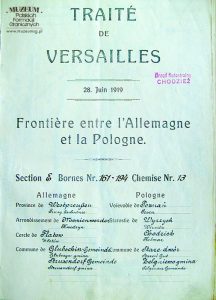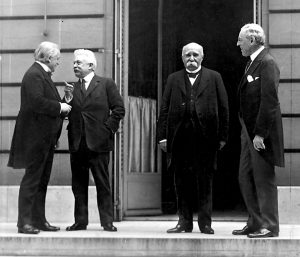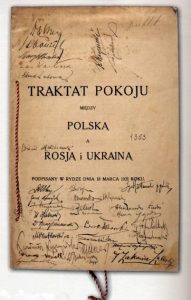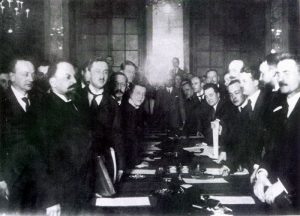The shape of the world after the First World War was to be decided at the peace conference in Paris. Officially the overriding principle guiding the discussions was national self-determination, but in reality the interests of the great world powers prevailed. The core task facing the conference was concluding a peace treaty with Germany as it had been the Allies’ key adversary in the First World War. The League of Nations was to safeguard the post-war world order and international peace.
Thanks to the participation in combat of General Haller’s Polish Army (set up in France) the Polish delegation had the right to take a place at the conference table as representatives of a “victorious Allied country”. The Polish diplomatic service prepared meticulously to fight for the national interest at the Paris conference. Distinguished Polish politicians and academics prepared a reasoned, theoretically grounded basis for the points of view to be presented. The most important issue for Poland was to gain borders which were fair and also secure.
The Treaty of Versailles which ended the First World War was signed by Germany and the Allied countries on 28 June 1919. It only definitively established certain parts of the Polish border. The participants of the peace conference did not define Poland’s border with Russia as they were counting on White Russians returning to power and overthrowing the Bolshevik government; however in article 87 of the Treaty of Versailles they did reserve the right to designate it at a later date. In practice this meant that Poles had to engage in combat with Russia to settle the border question.
Even the border with Germany was not wholly defined. The Treaty of Versailles granted Poland most of the lands of the Prussian Partition including Wielkopolska and Eastern Pomerania; it envisaged plebiscites in Upper Silesia and in Warmia, Masuria and Powiśle. The Treaty also provided for the creation of the Free City of Gdańsk. Another plebiscite was planned for Cieszyn Silesia. This was supposed to settle the division of the region between Poland and Czechoslovakia. Regardless of the outcomes of these plebiscites and the resolution of the eastern border question, it was already evident that Poland would be re-established as a sizeable country with a population of at least 30 million.
The main provisions of the treaty were accompanied by an addendum known as the Polish Minority Treaty (or Little Treaty of Versailles) which was imposed on Poland by the western powers. There is no question that the intentions behind this document were reasonable. Protecting the numerous ethnic minorities in Europe which found themselves within the apparatus of an alien state was a noble cause meriting full support. But in the case of Poland one-sided obligations were imposed without corresponding solutions for Polish populations outside its borders and there were a great many Poles in Germany, Czechoslovakia and Lithuania.

On 18 March 1921 Poland signed a peace treaty in Riga with Soviet Russia and the puppet republic Soviet Ukraine. It ended the Polish-Soviet War and delineated the border between the Republic of Poland and the Soviet state. This border split up Ukrainian and Belarusian lands. It gained international acceptance from the western states on 15 March 1923. In the peace treaty Soviet Russia accepted responsibility for paying Poland the sum of 30 million roubles in gold as compensation for the contribution made by Polish territories to developing the Russian economy during the period of the Partitions, but this commitment was never honoured. In the treaty Russia also committed to returning works of art and items of historical significance plundered during the Partitions.
The Treaty of Versailles, the Treaty of Riga and the Washington Naval Treaty, which regulated post-war issues in the area of the Pacific Basin, together determined the international order for almost two decades. Both under the leadership of Józef Piłsudski and while the Second Polish Republic remained in existence, Poland’s policy was to strive for peace and it tried — with mixed success — to maintain good relations with its neighbours.
In the 1930s the aggressive policies of the fascist block (Germany, Italy and Japan) on the one hand and the Soviet Union on the other led to the gradual dismantling of a peaceful world order and to the outbreak of the Second World War. The Treaty of Riga which officially dealt with settling relations between Poland and the Soviet state was in practice a keystone in maintaining order in the whole of eastern Europe. It formed a foundation for the independence of the countries which shared a border with Bolshevik Russia. The evidence for this lies in the fact that after the Soviet Union’s invasion of Poland in 1939 (carried out as part of a conspiracy with Nazi Germany) it did not take long for territorial changes to occur in that part of Europe with the USSR taking control of the states on the Baltic and parts of Finland and Romania (Bessarabia).



